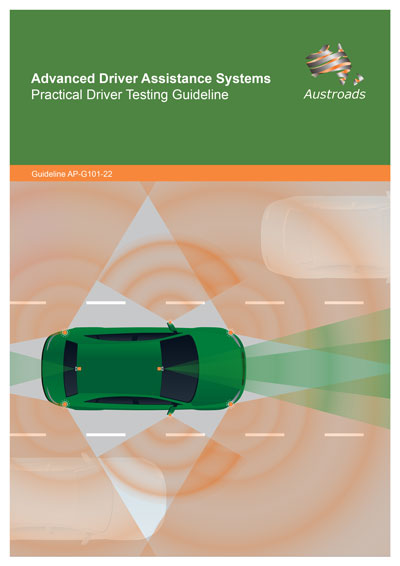Registration and Licensing

- Publication no: AP-G101-22
- ISBN: 978-1-922700-73-5
- Published: 14 December 2022
- PDF (free) Download
This Guideline describes common Advanced Driver Assistance Systems (ADAS) functions and their operational characteristics, including their limitations, and the conditions under which they may be allowed during on-road driver testing.
The Guideline has been designed to help licensing regulators and driver assessors respond to the increased presence of ADAS in the vehicle fleet. It may also be of use to learner drivers and people supervising driving practice such as parents and driver instructors.
Given that ADAS functions cannot be disabled, they present a new and unique challenges for on-road driver testing. Whatever ADAS are in operation during testing, drivers must still demonstrate, and examiners must still assess, the ability to operate a vehicle safely and show a maintained awareness of other road users and hazards in the road environment.
This Guideline focuses on ADAS functions classified by the Society of Automotive Engineers (SAE) as levels 0, 1 and 2. While self-driving or fully automated vehicles may have some ADAS functions, systems classified by SAE as Levels 3, 4 or 5 are not addressed.
While the Guideline has been designed to achieve the greatest level of national harmonisation, some jurisdictions may choose to implement driver testing processes that vary from those recommended in this Guideline.
Austroads is planning to develop this content further in 2023.
Disclaimer
In view of the dynamic nature of the underlying technology and continuous advances in the design and sophistication of Advanced Driver Assistance Systems (ADAS) functions the material presented here will be subject to continuous review. While all efforts have been made to ensure this Guideline is accurate at the time of publication, Austroads takes no responsibility for misapplication or misappropriation of the content in the Guideline or for changes to ADAS functions or systems since its publication date.
- Summary
- 1. Introduction
- 1.1 Purpose
- 1.2 Terminology
- 1.3 Testing Driver Competency
- 1.4 Driver Assessor Training
- 1.5 ADAS Functions Permitted During Testing
- 2. Considerations for Driver Testing and Assessor Training
- 3. ADAS Technologies
- Cameras
- Radar
- LiDAR
- Ultrasonic
- Global Positioning System (GPS)
- 4. ADAS Limitations
- Software Failure
- System Limitations
- Inattention
- Confusion
- Sensor Failure
- Infrastructure
- Map Accuracy
- Temporary Signage
- Hearing Impairment
- Operating Assumption
- Lack of Awareness and Knowledge
- Vehicle Differences
- 5. ADAS Functions
- 5.1 Hazard Warning Functions
- 5.1.1 Forward Collision Warning (FCW)
- 5.1.2 Rear Collision Warning (RCW)
- 5.1.3 Pedestrian, Cyclists and Obstacle Warning (PCOW)
- 5.1.4 Blind Spot Warning (BSW)
- 5.1.5 Rear Cross-Traffic Warning (RCtW)
- 5.1.6 Lane Departure Warning (LDW)
- 5.1.7 Parking Warnings (PW)
- 5.1.8 Intelligent Speed Assistance (ISA) – Passive
- 5.2 Vehicle Control Functions – Primary Safety
- 5.2.1 Hill Start Assist (HAS) (Permitted for Testing)
- 5.2.2 Intelligent Speed Assistance (ISA) – Active
- 5.2.3 Automatic Emergency Braking (AEB)
- 5.2.4 Automatic Emergency Steering (AES)
- 5.2.5 Reverse Automatic Emergency Braking (RAEB) (Approved for Testing)
- 5.2.6 Lane Keeping Assistance (LKA)
- 5.2.7 Lane Centering Assistance (LCA)
- 5.3 Vehicle Control Functions – Convenience
- 5.3.1 Cruise Control (CC) and Adaptive Cruise Control (ACC)
- 5.3.2 Active Parking Assistance (APA)
- 5.3.3 Active Driving Assistance (ADA)
- 5.1 Hazard Warning Functions
- References
